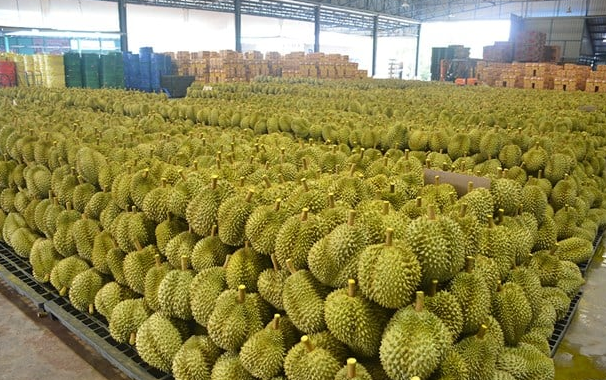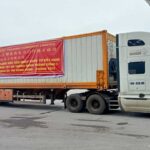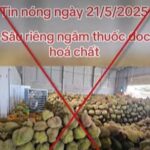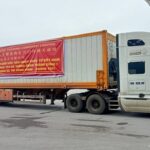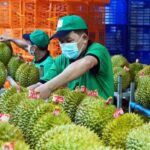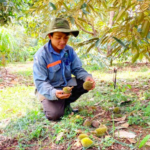
Illustration
In just under three years, durian has become one of the leading export products of Vietnam’s fruit and vegetable industry, contributing over $3.2 billion in 2024. However, this success story is now overshadowed by the consequences of rapid growth: numerous shipments being returned, businesses suffering heavy losses, farmers in confusion, and continuous warnings from the Chinese market about cadmium and banned substance residues, especially the yellow O chemical.
Recently, the Plant Protection Department revealed the main reasons for cadmium-contaminated soil, including natural factors such as soil properties and continuous cultivation without proper fallow periods. The subjective reason is the overuse of fertilizers by farmers, which exceeds recommended amounts.
Regarding the use of yellow O, China added regulations concerning this substance after detecting it on durians from Thailand. As it is often used post-harvest, China applies these regulations to all countries, including Vietnam, as a precautionary measure.
The Tien Phong Newspaper recently organized a workshop on “Sustainable Development of the Durian Industry,” conveying a message that without a change in management thinking and a strict control mechanism from input to output—and without strong linkages between the government, businesses, and farmers toward sustainable development—this billion-dollar industry of Vietnam could collapse at any time.
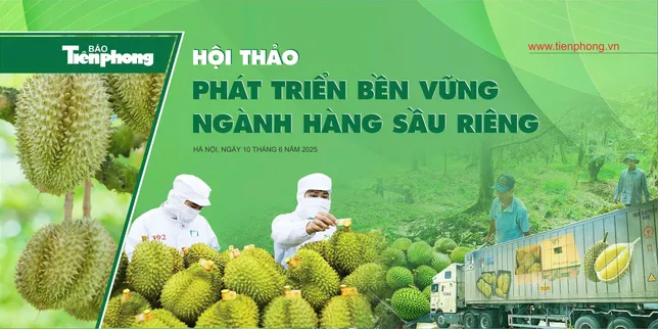
Are Farmers the Main Responsible Party?
Farmers, who are the first link in the value chain, are currently bearing the brunt of falling prices and facing criticism. However, according to Mr. Nguyen Quang Hieu, Deputy Director of the Plant Protection Department (MARD), the cause of cadmium-contaminated soil is partly natural, related to soil properties and continuous cultivation without fallow periods, along with the overuse of fertilizers beyond recommended amounts.
Mr. Hieu also emphasized that it is unfair to blame farmers entirely, as they lack deep expertise in soil chemistry and the impact of heavy metal accumulation. Notably, some organic fertilizers have been found to contain high levels of cadmium—something farmers cannot control without strict oversight from authorities.
Are Exporting Businesses “Not Involved”?
Businesses play a crucial role in connecting farmers to international markets. However, Mr. Dang Phuc Nguyen, Secretary-General of Vietnam Fruit and Vegetable Association, pointed out that uncontrolled and uncoordinated production, as well as post-harvest processing, have contributed to the current situation.
Some businesses, driven by profit, source raw materials from various regions without controlling the growing area codes. As a result, when one batch violates regulations, the entire area or industry suffers the consequences.
Additionally, the issue with the banned substance yellow O indicates a loophole in post-harvest management. Despite the Plant Protection Department’s strict prohibition, some businesses still use it, either due to a lack of control over farmers’ inputs or a lack of awareness about long-term consequences.
Responsibility of Management Agencies
Regarding state management, Mr. Phan Van Duy, Deputy Director of the Department of Quality Management, Processing and Market Development, acknowledged that Vietnam’s capacity for quality control is still weak and uncoordinated. Currently, only 34 facilities are certified for cadmium testing, and 19 facilities for yellow O testing—a small number compared to the actual needs.
Inspections are representative and cannot guarantee that all products meet the standards, while growing area codes and packaging facilities were not strictly controlled previously.
Moreover, as mentioned by Mr. Tran Viet Hung from the Market Management Department, the situation of trading fake and low-quality fertilizers and pesticides remains complex. Perpetrators take advantage of e-commerce and social media to distribute unapproved products containing banned substances or heavy metals, making it challenging to control from the source.
Misunderstandings About the Durian Industry That Need Clarification
Some recent opinions have suggested that imported DAP fertilizer from South Korea is the main cause of cadmium-contaminated soil. However, Mr. Nguyen Quang Hieu asserted that this perspective is not comprehensive. DAP fertilizer from South Korea accounts for only about 4% of the total DAP usage in Vietnam.
Additionally, organic fertilizers were found to contain higher levels of cadmium than inorganic fertilizers in some samples tested in the Mekong Delta. Therefore, the issue lies not with a specific type of fertilizer but with the uncontrolled use of fertilizers and the lack of transparency in the agricultural supplies market.
It is also important to clarify that not all growing areas are contaminated with cadmium. According to Dr. Nguyen Dang Nghia, the Central Highlands and the Southeast regions are being “wrongly accused,” as soil analysis in many areas shows acceptable cadmium levels.
The Way Forward: A Shared Responsibility
To restore trust in Vietnamese durian, all parties must take responsibility. The government should establish a quality monitoring system from the source, improve control of growing area codes, and strictly handle violations in the trading of agricultural supplies.
Businesses need to invest in supply chain control and not compromise the country’s reputation for short-term profits. Farmers should receive more comprehensive training on the use of fertilizers and pesticides and adhere to safe farming practices.
Most importantly, all actions must be based on transparency and consensus, avoiding one-sided blame—because in this story, each link in the value chain has its own responsibilities.
“Vietnamese Frozen Durian Exports to China: A Swift and Successful Negotiation”
“Just two days after the meeting between the Vietnamese Ministry of Agriculture and Environment and the General Administration of Customs of China, Vietnam exported its first batch of frozen durians to China. This marks a significant step forward in the trade cooperation of agricultural products between the two nations.”
The King of Fruits Faces an Uncertain Future: Unripe Durian Trees in Gia Lai Province Suffer a Devastating Blow.
In the face of extreme weather conditions, farmers in Gia Lai province witnessed a devastating sight as their young durians, no bigger than a fist, started falling off the trees en masse. This unexpected turn of events has left farmers in this mountainous region grappling with the stark reality of potential crop failure and significant financial losses.

